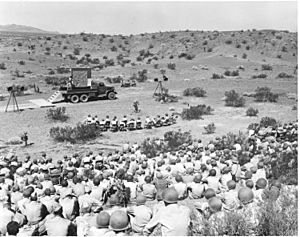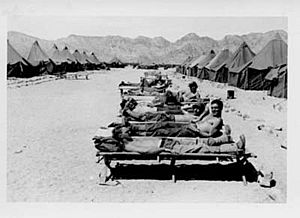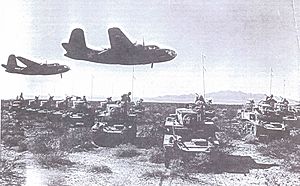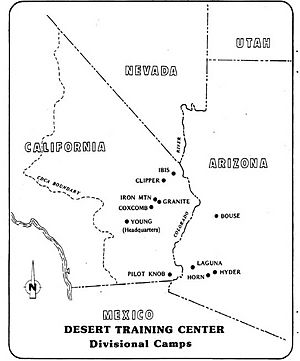Camp Iron Mountain facts for kids
Quick facts for kids Camp Iron Mountain |
|
|---|---|
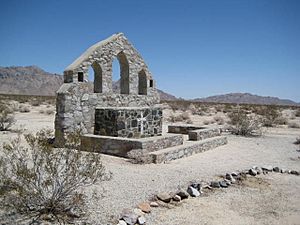
Catholic Chapel at Camp Iron Mountain
|
|
| Location | near Needles, California |
| Area | 67,907.504 acres |
| Built | 1942 |
| Architect | US Army |
| Reference no. | 985.4 |
| Lua error in Module:Location_map at line 420: attempt to index field 'wikibase' (a nil value). | |
Camp Iron Mountain was a special training camp for the U.S. Army during World War II. It was located in Riverside County, California. This camp was part of a much larger area called the Desert Training Center.
The main base for the Desert Training Center was Camp Young. This is where General Patton and his soldiers were based. Camp Iron Mountain is now recognized as a California Historical Landmark (No. 985.6).
You can find Camp Iron Mountain about 45 miles (72 km) east of Indio, California. It is near the Granite Mountains in San Bernardino County, California. In 1980, the Bureau of Land Management named Camp Iron Mountain an "Area of Critical Environmental Concern." This means it's a special place that needs protection. It is the best-preserved camp from the Desert Training Center. Fences were put up to keep off-road vehicles away.
Even today, you can still see some cool things at the camp. There's a huge map of the area built into the ground. There are also rock designs, two outdoor church altars, and old roads made of rocks. The camp gets its name from the nearby Iron Mountains.
Contents
Training Soldiers for War
Camp Iron Mountain was built very quickly in April 1942. Its main purpose was to get American soldiers ready for battle. They needed to learn how to fight in the hot, dry deserts of North Africa against the Nazis during World War II.
Two important groups of soldiers trained here. These were the 2nd Armored Division and the 80th Division. After their training, these troops went on to fight in the North African campaign.
The camp was quite large when it was finished. It had 15 shower buildings and 26 bathrooms. There were also 113 wooden frames for tents where the soldiers slept. The camp even had an outdoor theater. For water, there was a huge 4,000-gallon water tank and two smaller 3,000-gallon tanks.
Soldiers practiced their shooting skills at six different training ranges. They used rifles, handguns, and machine guns. The camp closed on March 16, 1944. The army used real bullets during training, so there are still warning signs at the site. The most well-preserved parts of the camp are two stone altars. One was built for Catholic services, and the other for Protestant services.
Camp Iron Mountain Airfield
Air Support for Training
A landing strip, or airfield, was built close to Camp Iron Mountain. This airfield helped support all the training activities. The runway was 4,500 feet long and made of strong steel mats.
Small planes used this airfield to watch the soldiers. They watched desert survival training and gun practice. They also helped coordinate tanks and other armored vehicles from the sky. After the war, this airstrip became the Iron Mountain Pumping Plant Airport. It is still used today.
California Historical Landmark Marker
What the Marker Says
There is a special marker at the site in Riverside, California. It tells us about the history of Camp Iron Mountain.
The marker reads:
- NO. 985 DESERT TRAINING CENTER, CALIFORNIA-ARIZONA MANEUVER AREA (ESTABLISHED BY MAJOR GENERAL GEORGE S. PATTON, JR.) - CAMP IRON MOUNTAIN - Iron Mountain Divisional Camp was established at this site in the Spring of 1942. One of eleven such camps built in the California-Arizona Desert to harden and train United States troops for service on the battlefields of World War II. The first major unit trained here was the 3rd Armored Division followed by elements of the 4th, 5th, 6th, and 7th Armored Divisions. In all, one million men trained in the desert before the Training Center was officially closed in May 1944. The most unique feature built at this camp is the huge relief map built into the desert floor. It can still be seen (1985).


